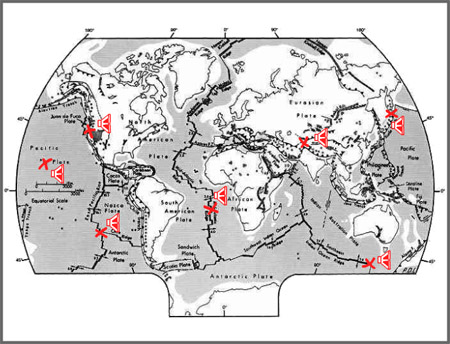Earth Instrument
 Artist Florian Dombois's Auditory Seismology project plays you the sound of earthquakes.
Artist Florian Dombois's Auditory Seismology project plays you the sound of earthquakes.Using time-compression to accelerate the vibrational waves of global seismic activity, Dombois makes landscape events audible to human ears. Specifically, he writes, "if one compresses the time axis of a seismogram by about 2000 times and plays it on a speaker (so called 'audification'), the seismometric record becomes hearable and can be studied by the ear and [by] acoustic criteria."
 In this map of global tectonics, for instance, you can listen to the weird, rubbery snapping of plate boundaries.
In this map of global tectonics, for instance, you can listen to the weird, rubbery snapping of plate boundaries. Dombois: "The sound of earthquakes at spreading zones differs much from earthquakes at subduction zones. Whereas earthquakes produced by plates that are drifting against each other appear as sharp and hard beats, an earthquake from a parting mid ocean ridge sounds more like a plop."
 Meanwhile, Dombois also introduces us to the sonic seismicity of southern California, where the aftershocks of 1994's Northridge quake sound like loose bits of metal banging against the side of a speeding bus. Then we go to Japan, whose plentiful subterranean dislocations come out like snaps of a drum. Finally, of course, we confront distance (the graph, featuring Earth's surface, mantle, and core, that appears at the top of this post). Clicking on the seismic stations listed round that graph, you get short ambient works that weave together to form endless varieties of terrestrial drones.
Meanwhile, Dombois also introduces us to the sonic seismicity of southern California, where the aftershocks of 1994's Northridge quake sound like loose bits of metal banging against the side of a speeding bus. Then we go to Japan, whose plentiful subterranean dislocations come out like snaps of a drum. Finally, of course, we confront distance (the graph, featuring Earth's surface, mantle, and core, that appears at the top of this post). Clicking on the seismic stations listed round that graph, you get short ambient works that weave together to form endless varieties of terrestrial drones.Click on more than one at the same time, and you can waste whole minutes of your life tuning faultlines and making dissonant chords of plates; the earth becomes your instrument.
Dombois's exhibition of Auditory Seismology closes November 18th, at the galerie rachel haferkamp in Cologne.
(Thanks, Alex! Earlier: Fault Whispers, Dolby Earth, resonator.bldg, Sound dunes, and, to some extent, Podcasting the sun).





Comments are moderated.
If it's not spam, it will appear here shortly!
Post a Comment